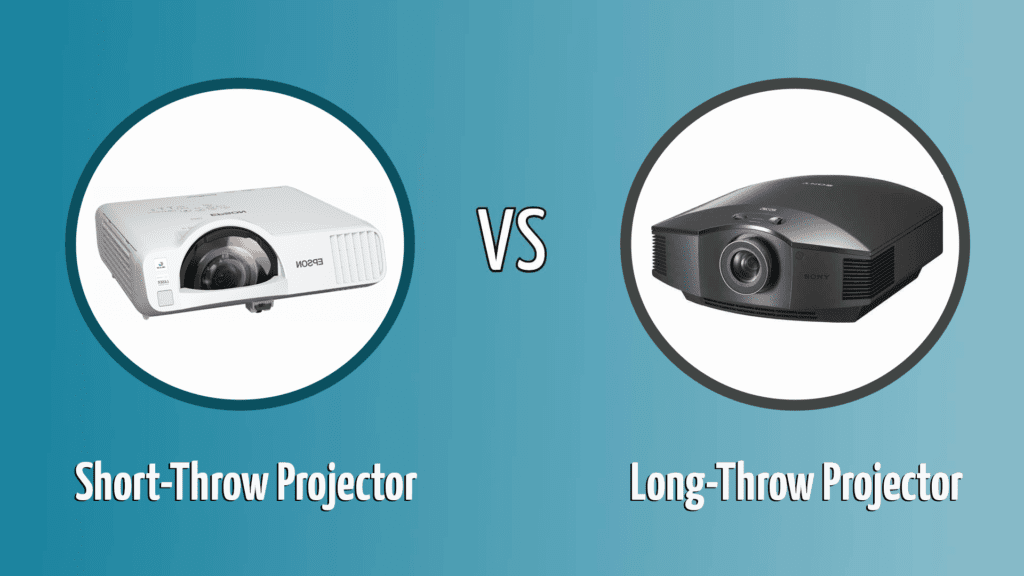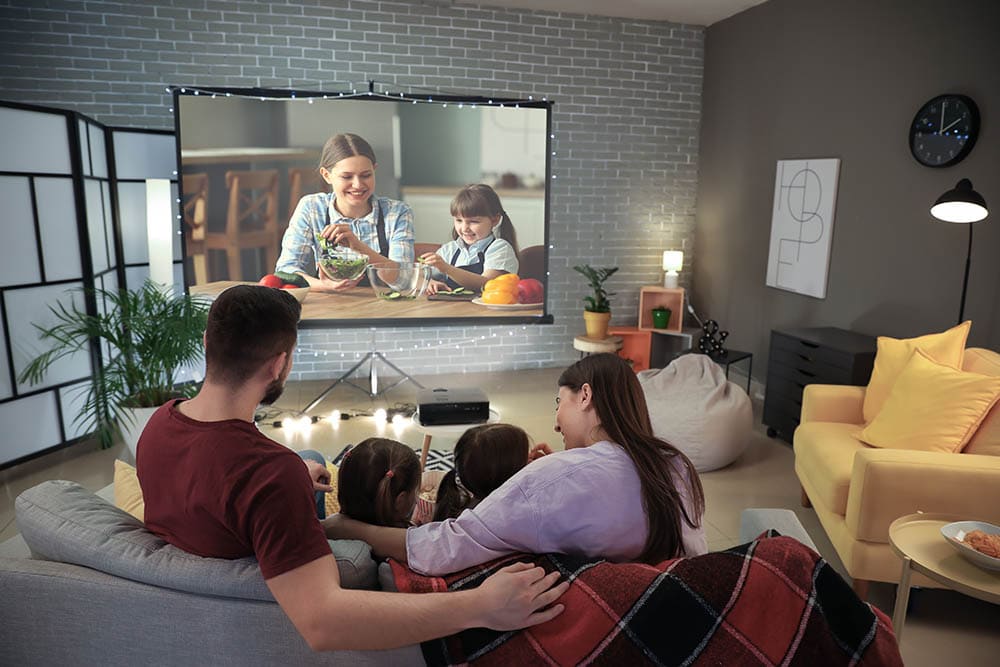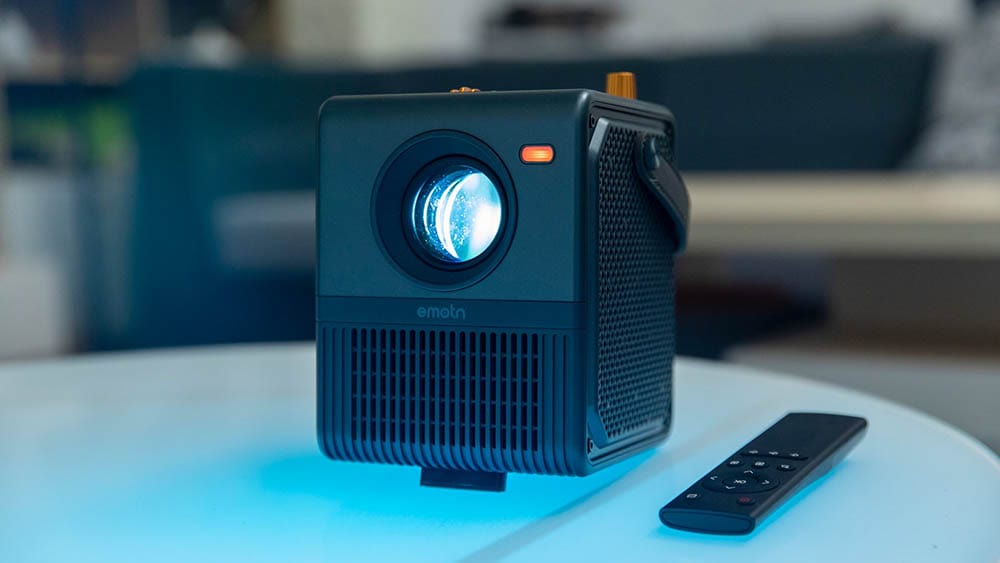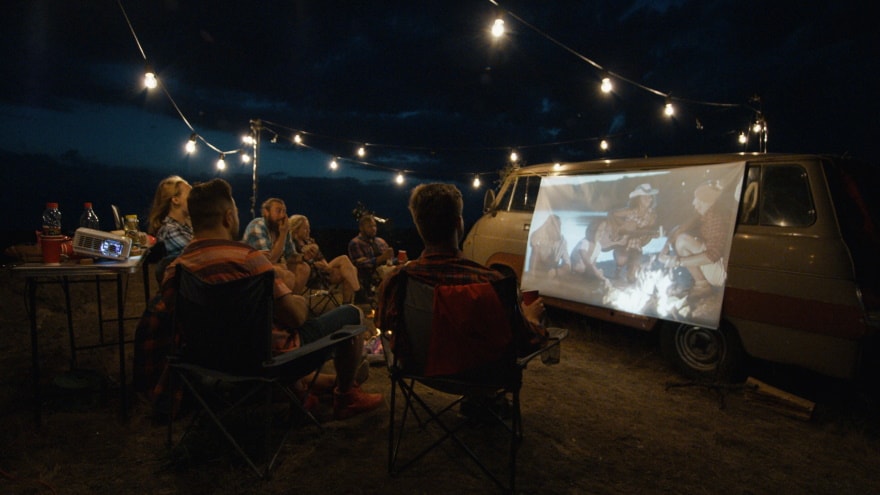Short-Throw Projector vs. Long-Throw: What Are the Differences?
Last Updated on

One of the most important decisions that you need to make when picking out a projector is whether you want a short-throw or a long-throw projector. But what are the differences between the two?
Here, we break down these projectors, help you decide which one is a better choice for you, and give you additional helpful tips!

Overview of Short-Throw Projectors

Short-throw projectors are more expensive than long-throw projectors, but why is that the case, and what exactly is a short-throw projector? We break it all down for you here.
What Is a Short-Throw Projector?
A short-throw projector is any projector that requires a shorter distance to reach a 100” screen size. Typically, people classify a short-throw projector as any projector that can reach this dimension in just 4 to 6 feet of space.
Short-throw projectors can come in a wide array of qualities and have plenty of different features. The short-throw term only refers to the distance that you need to place it to get the 100” screen size.
When Do You Need a Short-Throw Projector?
When space is at a premium, you’ll need a short-throw projector. This doesn’t just mean a small room, although that certainly applies. It also refers to a space where you would otherwise need to have people in front of the projector if you placed it too far back.
Short-throw projectors enable you to have a large screen size in a small space, and sometimes it’s your only option for a projector because of the layout of a room.

What Happens If You Move a Short-Throw Projector Farther Back?
While short-throw projectors work great at close distances, what happens if you find yourself in a situation where you need to move it back? While you might not think that it’s a big deal, the problem is that most short-throw projectors don’t have enough lumens to make up for the extra distance.
So, while image clarity shouldn’t suffer, it might not be bright enough to get a good view of what it’s trying to display. If you go with a short-throw projector, you’ll want to mount it at the appropriate distance. If you need to move it farther back, it’s better to go with a long-throw projector.
- Doesn’t require as much space
- Easier to keep people out of the way
- Provides a large screen in a tight space
- Expensive
- Need to have a close space to mount it

Overview of Long-Throw Projectors

If you’re in a large space and plan on putting your projector near the back, you want a long-throw projector. But why is that the case, and what exactly is a “long-throw” projector? The explanation is not as complicated as you might think, and depending on your setup, there’s a good chance that it’s what you want.
What Is a Long-Throw Projector?
While short-throw projectors can display an image up to 100” in 4 to 6 feet, a long-throw projector is any projector that requires more than 6 feet to reach the 100” image size.
Just like with short-throw projectors, a long-throw projector only refers to the distance that you need to reach the 100” screen size. They can come in both high and low resolutions, and they can have tons of extra features.
When Do You Want a Long-Throw Projector?
If you’re in a large space and plan on mounting your projector far away from your screen, that’s when you want a long-throw projector. It’s also more affordable than a short-throw projector, so if you have the space for both, you can typically save yourself a few hundred dollars by going with a long-throw option.
Another advantage of long-throw projectors is that if you need to make adjustments to the projector but don’t want to get in front of everyone, you can do so because you’re farther away from the screen.
However, keep in mind that if anything goes in front of the projector when it’s operating, it’ll block the light and distort the image.

What Happens If You Move a Long-Throw Projector Too Close?
While you need to put the projector at least 6 feet back to achieve a 100” screen, the only disadvantage of putting it at a closer distance is that you’ll get a smaller screen size.
There’s nothing wrong with that, of course, especially if you’re not looking for a 100” screen. However, if you need a large screen, you must push a long-throw projector farther back.
- Affordable
- Projects large images easily
- You can make changes from farther away
- People can easily get in the way
- You can’t move the projector closer without sacrificing screen size
Consider the Cost
When you’re comparing short-throw and long-throw projectors, you need to address the massive cost difference between the two.
Short-throw projectors cost far more than long-throw projectors. So, if you’re on a tight budget, a short-throw projector might not be an option for you. Expect to spend two to three times as much for a short-throw projector as a long-throw projector.
How Many ANSI Lumens Do You Need?
One of the biggest concerns with a projector is that bright lights can wash out the screen. However, too much light from the projector can lead to a lack of contrast in the image itself, so it’s a balancing act of getting the right projector for your needs.
Fortunately, every projector on the market measures brightness the same way, with ANSI lumens. A good rule of thumb for indoor settings is to allow 500 lumens/meter2. So, for most home theater applications, you want about 1,000 to 2,000 lumens.
However, if you’re looking for an outdoor projector, we recommend going brighter. For these settings, we recommend anywhere between 2,500 and 3,000 lumens for ideal picture quality.

How High Quality Can a Projector Get?
People used to think that you shouldn’t get a projector simply because it can’t be as high quality as a television. Today, that’s simply not the case.
Whether you want full HD or 4K, projectors can do it all. You’ll need to spend more to achieve this capability, but when you compare the cost to a television that can reach the same size, there’s no doubt that a projector is the cheaper option.
How high quality a projector can get is as high quality as you want it to be.
Do You Need a Projector Screen?
This depends on your particular setup, but if you’re projecting onto a white or gray wall, you don’t need a screen, but it will give you better-quality results and a more consistent image.
If the wall or area that you’re trying to project onto is a multi-colored or dark design, it’s going to significantly affect the final image.

Setting Up Your Projector
Before deciding on a projector, you have to determine how far away from the screen it will be and if you’re mounting it to the ceiling or putting it on a stand and if it’s going to be a permanent mount.
Keep in mind that if you plan on setting up your projector temporarily, you’ll need to fine-tune it each time to get a crystal-clear image. Furthermore, if you’re connecting different devices to stream from, consider how they’re going to connect when choosing a mounting spot.
Finally, you need to figure out how you’re powering it. There are battery-powered projectors, but they don’t always have the longest battery life to finish movies or for binge-watching your favorite show.
- When you need to sit close to the screen
- In small spaces
- When you’re on a tight budget
- When you need a large screen
- In large spaces

Conclusion
The last thing that you want is to spend a ton of money on a projector, only to realize that it’s not exactly what you need. Hopefully, this guide has helped clear up any confusion that you might have and gives you the confidence to go out and get the perfect projector for what you need!
About the Author Robert Sparks
Robert’s obsession with all things optical started early in life, when his optician father would bring home prototypes for Robert to play with. Nowadays, Robert is dedicated to helping others find the right optics for their needs. His hobbies include astronomy, astrophysics, and model building. Originally from Newark, NJ, he resides in Santa Fe, New Mexico, where the nighttime skies are filled with glittering stars.
Related Articles:
Holy Stone Drone Review of 2024 – Pros, Cons, and Verdict
Ultraviolet Light vs Black Light: What’s the Difference?
Light Waves vs. Sound Waves: How Are They Different?
Infrared vs. Thermal Cameras: How Are They Different?
Far Infrared vs Near Infrared: What’s The Difference?
Mottled Duck vs. Mallard vs. Black Duck: What’s the Difference?
Shutter Speed vs Frame Rate: Pros, Cons, & Difference
Oriole vs Goldfinch: How to Tell the Difference
